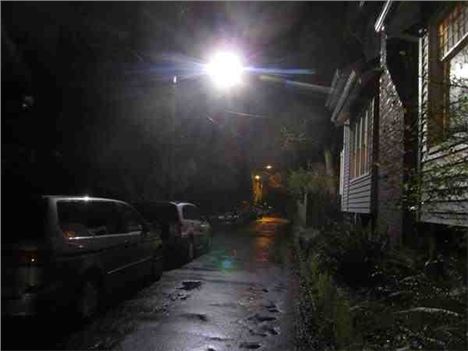ARE the stars out tonight? Do you know if it's cloudy or bright?”
Not in most bits of Merseyside, unfortunately. Light pollution sucks, especially if you're the sort who likes to stare up at the long arm of the Milky Way or wish upon a passing meteor shower.
But that might be about to change.
Sodium
Thousands of Liverpool’s ageing street lights are to be replaced with low-energy emititing LED bulb in a £7m “investment” that Liverpool City Council claim will produce millions of pounds of savings to the city.
The scheme will deliver major environmental benefits, it adds, including reduced carbon emission and night time pollution.
The council’s cabinet is to consider a recommendation that more than 20,000 of the existing yellow sodium lights, which have concrete posts, be replaced with LED lights on steel columns.
 Spot the difference: old style sodium lights (pic: Eric Scigliano)
Spot the difference: old style sodium lights (pic: Eric Scigliano)
The scheme, it estimates, will save the city £2.7m over its first five years.
“This is good news in every respect,” says Councillor Tim Moore, cabinet member for transport and climate change. “It means we will have improved lighting levels where we are introducing the new lights, making those areas safer.
“We will be a greener city as the level of CO2 emissions will be significantly reduced and night-time pollution will be cut.”
It is intended to replace 12,000 of the existing lights during 2014/15 with waterfront residential areas being targeted first. This, says the council, is is an area which has the greatest impact from salt and rain, causing the street lights to have the highest failure rate and the highest costs in replacement. A second phase, during 2015/6 will involve installing 8,000 LED lights in residential areas and replacing 1,380 older lights along key corridor routes.
In each of these phases, it says, there will be an 82pc reduction in energy consumption, producing savings of £533,000 per year.
Such LED schemes are gaining in popularity around the country, but are not without their critics.
Over in Greater Manchester, Trafford Council has stalled its plan to roll out a similar programme after a resident mounted a high court challenge, raising health concerns about the white light LEDs emit while questioning the projected cash savings.
Research by scientists from Madrid University suggests that light emitted by LEDs could damage retinas, especially of children, while an American study found that the lights could suppress melatonin, a brain hormone that regulates sleep. They are also thought by some scientists to disrupt circadian rhythms which have have also been linked with cancer.
Trafford has been forced to launch a review, despite previously saying the lights were safe, reports the Manchester Evening News.
 Blue is the colour: New style LED lamps (Pic by Eric Scigliano)
Blue is the colour: New style LED lamps (Pic by Eric Scigliano)
However, back in Liverpool, Cllr Moore says: “There will be long-term financial benefits to council taxpayers with energy and maintenance costs being significantly reduced. We will be using capital funding to pay for this programme but we really are investing in the city’s infrastructure to make considerable savings.”
If the programme here is approved, work will start shortly with the first phase taking about eight months to complete. It will be considered by the cabinet on 21 February.














